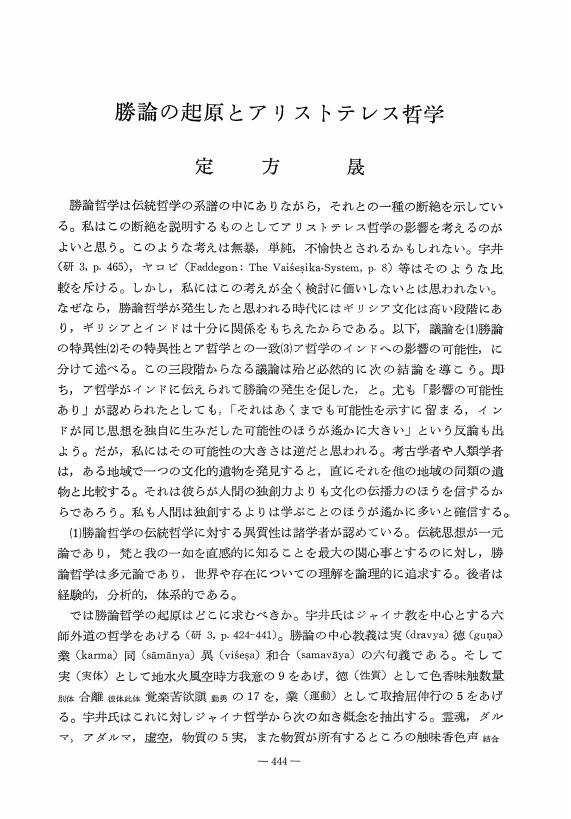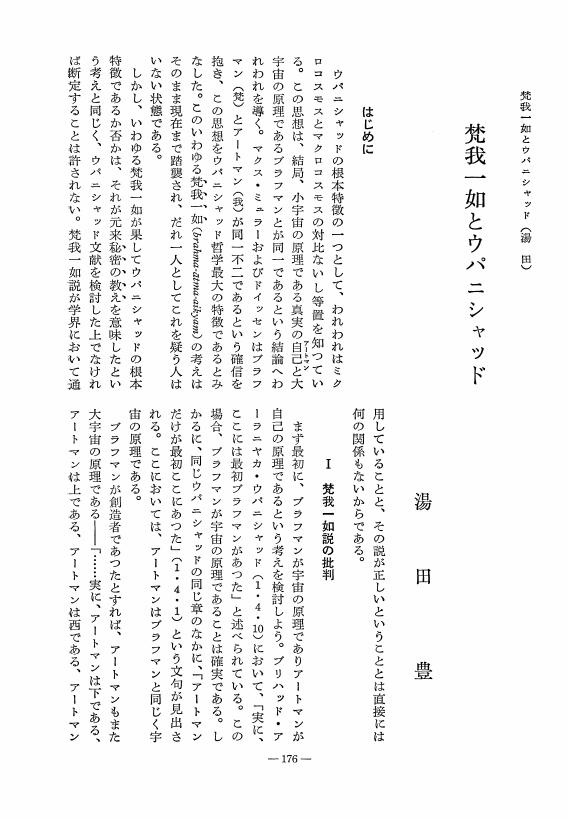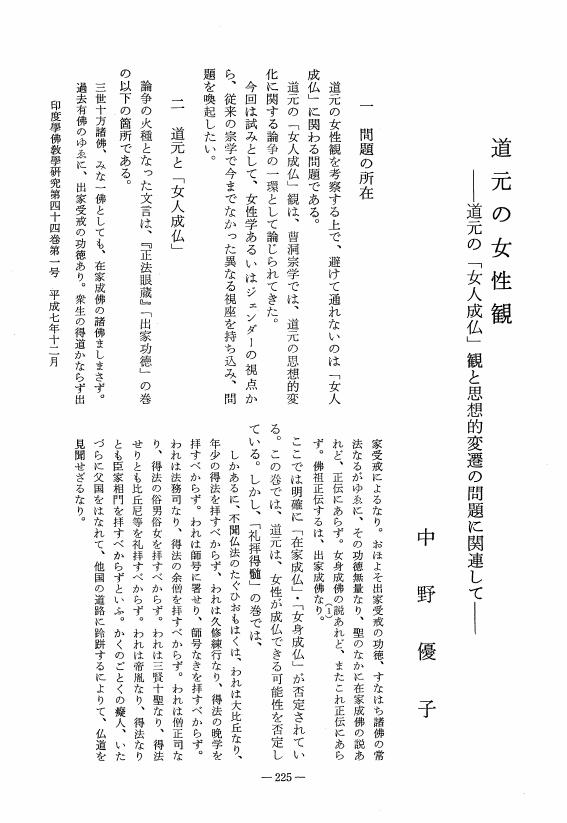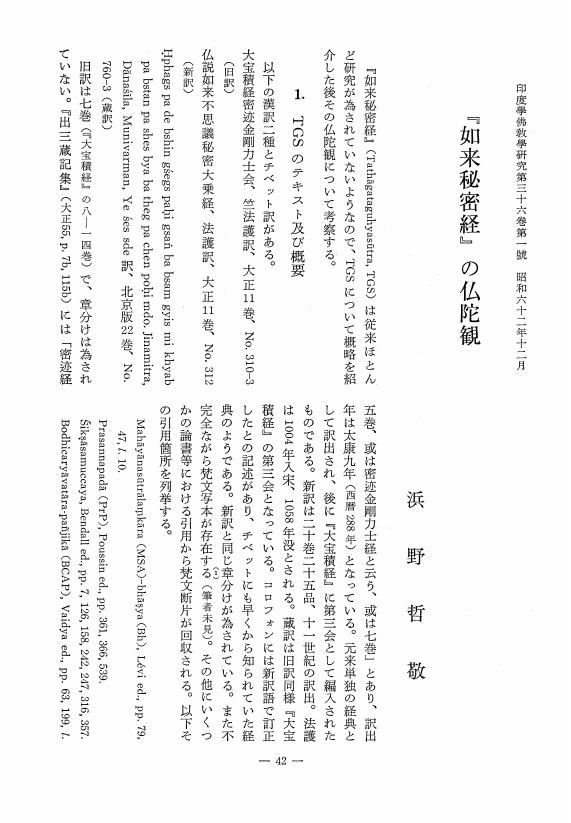2 0 0 0 OA 身心脱落考
- 著者
- 原田 弘道
- 出版者
- Japanese Association of Indian and Buddhist Studies
- 雑誌
- 印度學佛教學研究 (ISSN:00194344)
- 巻号頁・発行日
- vol.40, no.2, pp.744-750, 1992-03-20 (Released:2010-03-09)
- 被引用文献数
- 1
2 0 0 0 OA 勝論の起原とアリストテレス哲学
- 著者
- 定方 晟
- 出版者
- Japanese Association of Indian and Buddhist Studies
- 雑誌
- 印度學佛教學研究 (ISSN:00194344)
- 巻号頁・発行日
- vol.21, no.1, pp.444-437, 1972-12-31 (Released:2010-03-09)
2 0 0 0 OA 室町時代における浄土宗の特色 -とくに一条派を中心として-
- 著者
- 玉山 成元
- 出版者
- Japanese Association of Indian and Buddhist Studies
- 雑誌
- 印度學佛教學研究 (ISSN:00194344)
- 巻号頁・発行日
- vol.21, no.1, pp.68-73, 1972-12-31 (Released:2010-03-09)
2 0 0 0 OA 梵我一如とウパニシャッド
- 著者
- 湯田 豊
- 出版者
- Japanese Association of Indian and Buddhist Studies
- 雑誌
- 印度學佛教學研究 (ISSN:00194344)
- 巻号頁・発行日
- vol.25, no.1, pp.176-179, 1976-12-25 (Released:2010-03-09)
2 0 0 0 OA パーリ経典に説かれる「九次第定」の成立と構造
- 著者
- 藤本 晃
- 出版者
- Japanese Association of Indian and Buddhist Studies
- 雑誌
- 印度學佛教學研究 (ISSN:00194344)
- 巻号頁・発行日
- vol.53, no.2, pp.891-888, 2005-03-20 (Released:2010-03-09)
2 0 0 0 OA 日蓮遺文にみられる空海の著作
- 著者
- 岡田 榮照
- 出版者
- Japanese Association of Indian and Buddhist Studies
- 雑誌
- 印度學佛教學研究 (ISSN:00194344)
- 巻号頁・発行日
- vol.15, no.1, pp.146-147, 1966-12-25 (Released:2010-03-09)
2 0 0 0 OA 金子大栄著『浄土の観念』の一考察
- 著者
- 龍溪 章雄
- 出版者
- Japanese Association of Indian and Buddhist Studies
- 雑誌
- 印度學佛教學研究 (ISSN:00194344)
- 巻号頁・発行日
- vol.32, no.1, pp.152-153, 1983-12-25 (Released:2010-03-09)
2 0 0 0 OA 五姓格別の源流を尋ねて
- 著者
- 佐久間 秀範
- 出版者
- Japanese Association of Indian and Buddhist Studies
- 雑誌
- 印度學佛教學研究 (ISSN:00194344)
- 巻号頁・発行日
- vol.55, no.3, pp.1112-1120, 2007-03-25 (Released:2010-03-09)
- 参考文献数
- 7
ねらい (目的): 五姓格別というと唯識教学の旗印のように日本では考えられてきたが, 吉村誠氏, 橘川智昭氏などの研究から法相宗の事実上の創始者窺基に由来することが判った. 窺基はそれ以前の中国唯識思想が如来蔵思想に歪められていたことへの猛反発から玄奘がもたらした正統インド唯識思想を宣揚しようとし, 一乗思想の対局の五姓格別を持ち出したと考えられる. それならば五姓格別思想も, その起源をインドに辿れるはずである. これまでインドの文献資料の中にその起源を位置づける研究が見あたらなかったので, これを明らかにすることを目的としたのが当論文である.方法 (資料): 全体を導く指標として遁倫の『瑜伽論記』の記述を用い, 法相宗が五姓格別のインド起源の根拠と位置づける『瑜伽論』『仏地経論』『楞伽経』『大乗荘厳経論』(偈文, 世親釈, 無性釈, 安慧釈) と補足的資料として『勝鬘経』『般若経』に登場する当思想に関連するテキスト部分を逐一分析し, その歴史的道筋を辿った.本論の成果等: 諸文献のテキスト部分を分析した結果, 五姓格別思想は三乗思想と無因子の無種姓とが合成されたものであることが判った. その過程を辿れるのが『大乗荘厳経論』第三章種性品であり, 無種姓という項目が声聞, 独覚, 菩薩, 不定種性と並列された第五番目に位置づけられるようになったのは, 最終的には安慧釈になってからであることが歴史的な発展過程とともに明らかになった. その場合玄奘のもたらした瑜伽行派文献の中国語訳に基づく五姓格別思想は, 玄奘が主として学んだナーランダーの戒賢等の思想と云うよりも, ヴァラヴィーの安慧系の思想を受け継ぐものと考えられる. これは智と識の対応関係などにもいえることであるが, 法相宗の思想の基盤が従来考えられたようなナーランダーにあると云うよりも, ヴァラヴィーなど他の地域に依拠しているケースが認められたと云うことであり, これまでの常識とされていた中国法相教学の思想の位置づけを含めて, 教理の内容を吟味してゆくことを要求する内容となった.
2 0 0 0 阿日房彰空と樋口安養寺
- 著者
- 上田 良準
- 出版者
- JAPANESE ASSOCIATION OF INDIAN AND BUDDHIST STUDIES
- 雑誌
- 印度學佛教學研究 (ISSN:00194344)
- 巻号頁・発行日
- vol.9, no.1, pp.306-310, 1961
2 0 0 0 OA 菩薩思想の源流に就いて
- 著者
- 石川 海淨
- 出版者
- Japanese Association of Indian and Buddhist Studies
- 雑誌
- 印度學佛教學研究 (ISSN:00194344)
- 巻号頁・発行日
- vol.1, no.1, pp.146-152, 1952-07-20 (Released:2010-03-09)
2 0 0 0 OA 御遺告の成立過程について
- 著者
- 武内 孝善
- 出版者
- Japanese Association of Indian and Buddhist Studies
- 雑誌
- 印度學佛教學研究 (ISSN:00194344)
- 巻号頁・発行日
- vol.43, no.2, pp.607-611, 1995-03-25 (Released:2010-03-09)
2 0 0 0 OA 神会の無念について
- 著者
- 瀧瀬 尚純
- 出版者
- Japanese Association of Indian and Buddhist Studies
- 雑誌
- 印度學佛教學研究 (ISSN:00194344)
- 巻号頁・発行日
- vol.52, no.2, pp.648-650, 2004-03-20 (Released:2010-03-09)
2 0 0 0 OA 道元の女性観-道元の「女人成仏」観と思想的変遷の問題に関連して-
- 著者
- 中野 優子
- 出版者
- Japanese Association of Indian and Buddhist Studies
- 雑誌
- 印度學佛教學研究 (ISSN:00194344)
- 巻号頁・発行日
- vol.44, no.1, pp.225-228, 1995-12-20 (Released:2010-03-09)
2 0 0 0 OA 『如来秘密経』の仏陀観
- 著者
- 浜野 哲敬
- 出版者
- Japanese Association of Indian and Buddhist Studies
- 雑誌
- 印度學佛教學研究 (ISSN:00194344)
- 巻号頁・発行日
- vol.36, no.1, pp.42-46, 1987-12-25 (Released:2010-03-09)
2 0 0 0 OA 親鸞の妻恵信尼考 -親鸞の妻は宜秋門院であると思う-
- 著者
- 藤井 元了
- 出版者
- Japanese Association of Indian and Buddhist Studies
- 雑誌
- 印度學佛教學研究 (ISSN:00194344)
- 巻号頁・発行日
- vol.23, no.1, pp.178-179, 1974-12-25 (Released:2010-03-09)
2 0 0 0 OA 『天神経』について
- 著者
- 服部 法照
- 出版者
- Japanese Association of Indian and Buddhist Studies
- 雑誌
- 印度學佛教學研究 (ISSN:00194344)
- 巻号頁・発行日
- vol.42, no.1, pp.184-187, 1993-12-25 (Released:2010-03-09)
2 0 0 0 OA 『梵網経』における「自誓受戒」について
- 著者
- 任 京美
- 出版者
- Japanese Association of Indian and Buddhist Studies
- 雑誌
- 印度學佛教學研究 (ISSN:00194344)
- 巻号頁・発行日
- vol.54, no.1, pp.512-509,1286, 2005-12-20 (Released:2010-07-01)
One characteristic of Mahayana bodhisattva precepts is the idea of “self-ordination”. In the case where one has no teacher, self ordination means vowing to keep the Buddhist precepts personally. Although in self ordination the spiritual aspect is stressed, there also need to be certain conditions for it to take place. This characteristic is explained in the idea of “visionary experience”, found in the 23rd precept of the Fanwang jing. This essay examines the influence of selfordination as found in the Fanwang jing, taking into account the Huayan jing and the point of view of practice.Visionary experience is built up through practice. In this way, the visionary experience is based on practice, and the person who completes “self ordination” follows the influence of the Huayan jing in the Fanwang jing, hence bodhisattva non-regression is necessary for visionary experience. The disciple of the Buddha is penitent, practices and sees the visionary experience as proof of ordination. Accordingly, the visionary experience found in “self ordination” of the Fanwang jing should be understood from the point of view of practice.
2 0 0 0 OA 『花郎世紀』における諸問題
- 著者
- 福士 滋稔
- 出版者
- Japanese Association of Indian and Buddhist Studies
- 雑誌
- 印度學佛教學研究 (ISSN:00194344)
- 巻号頁・発行日
- vol.43, no.1, pp.262-266, 1994-12-20 (Released:2010-03-09)
2 0 0 0 OA 明治期曹洞宗における宗教運動
- 著者
- 深瀬 俊路
- 出版者
- Japanese Association of Indian and Buddhist Studies
- 雑誌
- 印度學佛教學研究 (ISSN:00194344)
- 巻号頁・発行日
- vol.39, no.2, pp.770-773, 1991-03-20 (Released:2010-03-09)
2 0 0 0 OA 「のぞきからくり」の地獄絵
- 著者
- 根井 浄
- 出版者
- Japanese Association of Indian and Buddhist Studies
- 雑誌
- 印度學佛教學研究 (ISSN:00194344)
- 巻号頁・発行日
- vol.54, no.1, pp.241-248,1261, 2005-12-20 (Released:2010-03-09)
Nozoki Karakuri is a street performance. It took place in the 17th century. Spectators watch moving dolls and pictures, and so on, through a glass window in a box. Among the painted pictures, many were drawn from the idea of Buddhist Hell and Paradise. Nozoki Karakuri has been preserved in Fukae town, Nagasaki prefecture. It is one of the cultural treasures of Japanese Buddhism.















